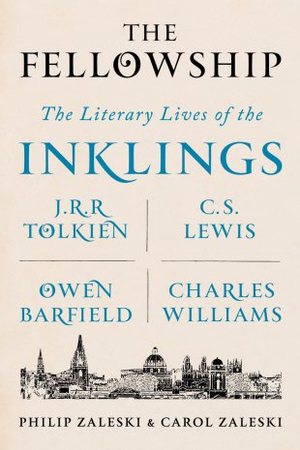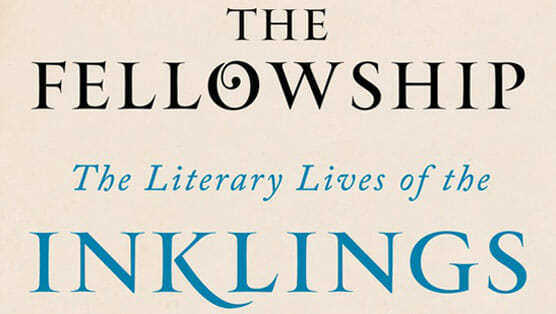Inklings Assemble!
That chapter title, coming at around the 200-page mark of this rather thorough biography, has a fittingly intrepid ring to it. One might imagine the four famous writers profiled as raising their pens in allegiance, forging a sort of Fellowship of prose amid a backdrop of fantastical scenery.
 J.R.R. Tolkien and C.S. Lewis are among the most famous writers of the 20th century, known the world over for their respective creations, Middle Earth (The Hobbit/The Lord Of The Rings) and Narnia (The Lion, The Witch & The Wardrobe). They were both significantly influenced by a fellow writer during their days at Oxford named Owen Barfield. Barfield, in fact, was also a playwright, philosopher, poet and, notably, a lover of music. The next most prominent and influential member of The Inklings would be an “author and publisher of ‘supernatural shockers’” named Charles Williams.
J.R.R. Tolkien and C.S. Lewis are among the most famous writers of the 20th century, known the world over for their respective creations, Middle Earth (The Hobbit/The Lord Of The Rings) and Narnia (The Lion, The Witch & The Wardrobe). They were both significantly influenced by a fellow writer during their days at Oxford named Owen Barfield. Barfield, in fact, was also a playwright, philosopher, poet and, notably, a lover of music. The next most prominent and influential member of The Inklings would be an “author and publisher of ‘supernatural shockers’” named Charles Williams.
So then, who were the Inklings? If American readers are coming to this English-born renaissance in mythology and fantasy writing merely out of recent Peter Jackson-induced Lord of the Rings fandom or their grade-school nostalgia for Narnia, then they’re in for a far greater journey. This is a story of the influence that both World Wars (and the intervening Great Depression) had upon the literary and spiritual lives of the members of a writing club that convened inside a cozy pub just beside the University of Oxford:
…a small circle of intellectuals gathered on a weekly basis in and around Oxford University to drink, smoke, quip, cavil, read aloud their works in progress, and endure or enjoy with as much grace as they could muster the sometimes blistering critiques that followed…
Thus begins Philip and Carol Zaleski’s 500-page portrait of the writing party within which Lewis and Tolkien cut their teeth. The Inklings, throughout the 1930s, would often meet in a Pub known as the Eagle and Child, but the regulars referred to it as the Bird and Baby. The Zaleskis note that the wittier observer would presume the Inklings aims would have been to turn that bird into a dragon and the baby into a king. “…for their sympathies were mythological, medieval, and monarchial, and their great hope was to restore Western culture to its religious roots, to unleash the powers of the imagination…”
This book, which credits the ingenious quartet of writers for enchanting readers, goes to a great length to emphasize how much of their writing, albeit fantastical, was guided by Christian faith and a longing to “reclaim the goodness, the beauty” that had been disrupted by the Great War.
The most horrific moments of both World Wars seemed like the very end of the world to these writers. They believed, as the Zaleskis put it, “that ours is a fallen world yet not a forsaken one.” So if the Inklings’ pages of writing demonstrated “a longing for tradition and reenchantment through the literature of fantasy,” then this book unfolds a story of how, for Lewis, Tolkien, Barfield and Williams, that fantasy “became the voice of faith.” For the Inklings at Oxford during the years of war, fantasy literature was an interesting sort of enlightenment, “an intimation of a different, higher, purer world or state of being.” It was through myth and symbols, through Hobbit holes and old dusty wardrobes, that they could pen a pathway to this higher world.
But that’s just the beginning of the story. Anyone looking to this book as an entertaining addendum to further understanding the LOTR or Narnia universes should gird themselves for a more scholarly discourse. Is it dry at some points? Certainly. Slow…perhaps, but that depends on why you begin your own exploration of the Inklings in the first place.
The Inklings, going against the grain by embracing more traditionalist forms and fundamentals of storytelling, were aiming toward “squarely addressing modern anxieties and longings” through their writings. Whatever they were in their heyday, a club or a cabal or a clique, their modern influence has come to constitute “a literary force.” But, as the Zaleskis note in their closing, the nuance of their influence and the impact of their work changes as generations proceed.
The future may yet decide differently on their significance.

 J.R.R. Tolkien and C.S. Lewis are among the most famous writers of the 20th century, known the world over for their respective creations, Middle Earth (The Hobbit/The Lord Of The Rings) and Narnia (The Lion, The Witch & The Wardrobe). They were both significantly influenced by a fellow writer during their days at Oxford named Owen Barfield. Barfield, in fact, was also a playwright, philosopher, poet and, notably, a lover of music. The next most prominent and influential member of The Inklings would be an “author and publisher of ‘supernatural shockers’” named Charles Williams.
J.R.R. Tolkien and C.S. Lewis are among the most famous writers of the 20th century, known the world over for their respective creations, Middle Earth (The Hobbit/The Lord Of The Rings) and Narnia (The Lion, The Witch & The Wardrobe). They were both significantly influenced by a fellow writer during their days at Oxford named Owen Barfield. Barfield, in fact, was also a playwright, philosopher, poet and, notably, a lover of music. The next most prominent and influential member of The Inklings would be an “author and publisher of ‘supernatural shockers’” named Charles Williams.